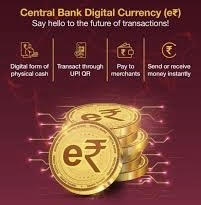Cryptocurrencies, especially Bitcoin, have gained considerable global attention, but a significant development is also taking place in India with the launch of the “e-rupee,” or digital currency, by the Reserve Bank of India (RBI). This initiative represents a crucial advancement in the evolution of money.
 The e₹ (e-rupee) is set to function as legal tender in a digital format, with major banks in India gradually informing their customers about its applications. The objective is to integrate digital currency into everyday financial transactions, much like how ATMs and credit cards are used today.
The e₹ (e-rupee) is set to function as legal tender in a digital format, with major banks in India gradually informing their customers about its applications. The objective is to integrate digital currency into everyday financial transactions, much like how ATMs and credit cards are used today.The e-rupee introduces a new category of currency that is coded, sovereign, and programmable, which could redefine our understanding of currency value and financial interactions. This transition promises not only greater convenience but also empowers individuals to have increased control over their financial futures. Through this initiative, India is positioning itself as a leader in a transformative financial landscape.
The e-rupee functions similarly to paper money but offers programmable features that can dictate how, when, and where it is used. This capability introduces a new level of control in financial transactions.
An essential aspect of this system is the e-wallet, a digital wallet that allows users to manage and store digital rupees conveniently on their mobile devices. E-wallets are considered secure, often more so than traditional payment methods such as credit cards or cash, provided they are used correctly.
A notable example of the e-rupee’s application is the Subhadra Yojana, launched in Odisha in September 2024, where Rs 10,000 in digital rupees was directly transferred to 12,000 women quickly, securely, and without intermediaries. This transaction demonstrated the potential for digital accountability, illustrating how CBDCs can enable targeted financial support for specific purposes, thereby transforming governance and welfare distribution.
where Rs 10,000 in digital rupees was directly transferred to 12,000 women quickly, securely, and without intermediaries. This transaction demonstrated the potential for digital accountability, illustrating how CBDCs can enable targeted financial support for specific purposes, thereby transforming governance and welfare distribution.
 where Rs 10,000 in digital rupees was directly transferred to 12,000 women quickly, securely, and without intermediaries. This transaction demonstrated the potential for digital accountability, illustrating how CBDCs can enable targeted financial support for specific purposes, thereby transforming governance and welfare distribution.
where Rs 10,000 in digital rupees was directly transferred to 12,000 women quickly, securely, and without intermediaries. This transaction demonstrated the potential for digital accountability, illustrating how CBDCs can enable targeted financial support for specific purposes, thereby transforming governance and welfare distribution.Currently, over 130 countries are exploring central bank digital currencies. In India, tests for offline payments, interbank settlements, and regulated cross-border operations are already in progress, particularly with the UAE and ASEAN nations.
The shift towards sovereign digital money will have significant implications for investors and market participants. This transition is expected to enhance transparency, requiring companies to adapt their payment processes. It will enable clearer visibility into the performance of various fintech enterprises and may streamline operations in banking, microfinance, and regulatory compliance.
Digital currency represents a strategic evolution of India’s monetary structure, impacting policies, investment opportunities, and the mechanics of financial transactions. Financial professionals who overlook this shift risk missing new emerging pathways, while those who embrace it may find new avenues for investment as the future of money unfolds.

